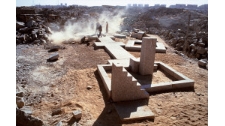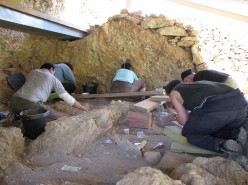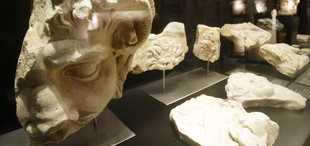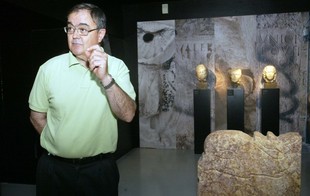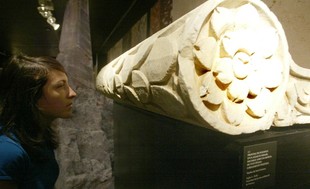Fotografía cedida el 25 de mayo, en la que se observan parte de los
diecisiete esqueletos humanos con ofrendas
del periodo Posclásico
Temprano (900-1150), que fueron encontrados durante unas obras en las
cercanías del
centro histórico de San Pedro de Cholula, estado de
Puebla (México), informó este lunes el Instituto Nacional de
Antropología e Historia (INAH). - EFE
EFE - Balancán (México) - 27/05/2009 12:33
El
hallazgo de 23 piezas arqueológicas del año 600 a.C. ha reforzado la
importancia histórica de la ciudad maya de Moral-Reforma, un puerto
fluvial ubicado en el actual estado de Tabasco, que era casi
desconocido hasta que un grupo de especialistas comenzó a excavarlo
hace tres meses.
El sitio arqueológico, de 87 hectáreas de
extensión, se ubica junto a la comunidad de Reforma, una población
rural dedicada a la ganadería.
La comunidad pertenece al
municipio de Balancán, que en maya significa "lugar de tigres y
serpientes", y está localizada a 250 kilómetros de Villahermosa, la
capital de Tabasco, en el sureste mexicano.
Benito López, uno de
los dos expertos que lideran la excavación, explicó a Efe que
Moral-Reforma funcionó como un puerto o lugar de trueque con otras
ciudades mayas de los estados mexicanos de Campeche, Chiapas y de
Guatemala.
Cerca de estos vestigios se unen los ríos Usumacinta -el mayor del país- y San Pedro, vía de comunicación con el sur de México.
"La
hipótesis nos dice que esta zona pudo ser de paso para aquellos que
sólo buscaban comercializar", señaló López en el sitio arqueológico,
donde las temperaturas alcanzan los 45 grados centígrados en esta época
del año.
Los primeros trabajos de investigación realizados en las
estructuras principales de este puerto maya datan de hace 17 años, y ya
se han restaurado algunos de sus principales monumentos, entre los
cuales destaca un tradicional juego de pelota y tres edificaciones.
Cinco
estelas de piedra con inscripciones, algunas completas y otras
fragmentadas, provenientes de esta zona se encuentran actualmente
exhibidas en el museo de Balancán y en el Museo Carlos Pellicer de
Villahermosa.
El equipo de arqueólogos se encuentra desde hace
tres meses investigando los alrededores y los dos primeros niveles del
edificio principal, una pirámide cubierta de tierra que se localiza en
el extremo norte de la ciudad indígena y se parece a las ruinas de
Calakmul, en el vecino estado de Campeche.
Al subir los primeros
quince escalones de esa edificación se pueden observar una serie de
altares descubiertos en las últimas semanas, los cuales "seguramente
estaban pintados y estucados", según el especialista.
Mascaras,
pequeñas esculturas, piedras, puntas de lanzas y cabezas pigmentadas en
color verde componen las 23 piezas halladas gracias a las labores
arqueológicas en las áreas contiguas a la pirámide.
"Hoy por la
mañana encontramos otra carita de un personaje; estas piezas son de
piedra caliza, de pedernal, del mismo material con que están hechas las
pirámides", dijo López durante un recorrido por las ruinas.
Las
piezas encontradas hasta ahora fueron enviadas el pasado lunes a la
oficina del Instituto Nacional de Antropología e Historia (INAH) con
sede en Villahermosa para su restauración.
De acuerdo con las
investigaciones, Moral-Reforma formó parte del señorío de Palenque, una
de las principales ciudades mayas de México, establecida en el estado
de Chiapas.
Francisco Cuevas Reyes, el otro especialista que
dirige la excavación, detalló que en la zona existen otros 95
montículos que podrían guardar más piezas o edificaciones.
"La extensión del sitio es mayor, con estos trabajos el pueblo está tomando forma", apuntó.
Los
especialistas calculan que en agosto próximo, se habrá excavado ya el
50 por ciento de la pirámide principal, con la colaboración de un
equipo de alrededor de 100 obreros, en su mayoría hombres de las
comunidades rurales cercanas a la comunidad de Reforma.
Carlos
Cajija Álvarez es uno de los hombres de confianza de los arqueólogos.
No sólo lleva un registro de las piezas encontradas, sino que supervisa
el trabajo de los demás obreros.
"No cualquiera puede trabajar
aquí, a los desesperados no se les contrata porque aquí el requisito es
tener paciencia", dijo Cajija Álvarez en declaraciones a Efe, que
construía casas antes de introducirse en el misterioso mundo de la
arqueología.
La civilización maya alcanzó su máximo esplendor
entre el 250 a.C y el 1000 de nuestra era, y habitó en la zona de
Mesoamérica, en los actuales estados mexicanos de Tabasco, Chiapas,
Campeche, Yucatán y Quintana Roo, así como en lo que hoy son los países
centroamericanos de Belice, Guatemala, El Salvador y Honduras.
Construyeron
ciudades y centros ceremoniales entre los que destacan Palenque,
Yaxchilán, Edzná, Labná, Sayil, Kabah, Cobá, Dzibilchaltún, Toniná,
Mayapán, Chichén Itzá, Tulum, Uxmal, Tikal, Copán y Bonampak.
http://www.publico.es/agencias/efe/228301/excavan/casi/desconocido
/puerto/fluvial/maya/sureste/mexico
































